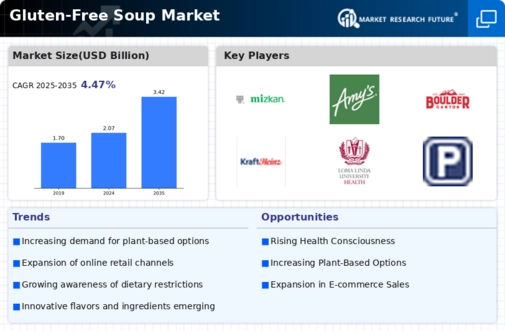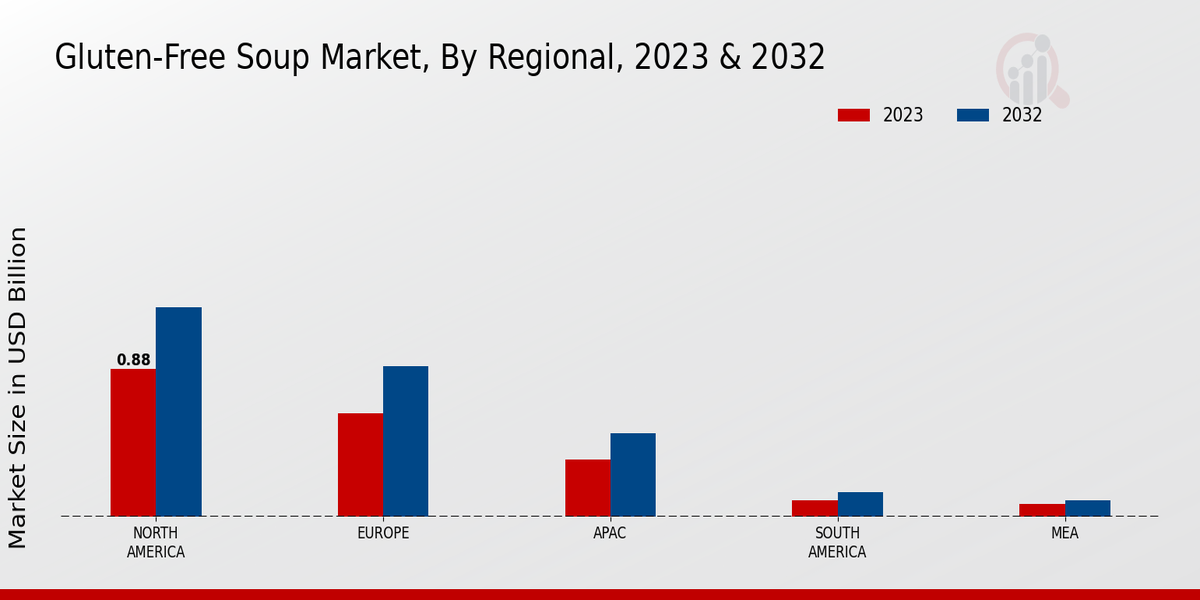Market Growth Projections
The Global Gluten-Free Soup Market Industry is projected to experience substantial growth over the coming years. With a market value of 2.07 USD Billion in 2024, it is expected to reach 3.42 USD Billion by 2035, reflecting a compound annual growth rate of 4.65% from 2025 to 2035. This growth trajectory indicates a robust demand for gluten-free soup products, driven by various factors including health consciousness and dietary preferences. The market's expansion is likely to attract new entrants and encourage existing players to innovate, thereby enhancing competition and product diversity.
Rising Health Consciousness
The increasing awareness of health and wellness among consumers appears to be a primary driver for the Global Gluten-Free Soup Market Industry. As individuals become more informed about dietary restrictions and the benefits of gluten-free options, the demand for gluten-free soups is likely to rise. This trend is particularly evident in regions with higher incidences of gluten intolerance and celiac disease. The market is projected to reach 2.07 USD Billion in 2024, reflecting a growing consumer base that prioritizes healthful eating. Consequently, manufacturers are responding by innovating and expanding their gluten-free product lines to cater to this health-conscious demographic.
Diverse Culinary Preferences
The Global Gluten-Free Soup Market Industry is experiencing growth due to the increasing diversity in culinary preferences among consumers. As globalization continues to influence food choices, there is a rising demand for soups that cater to various dietary needs, including gluten-free options. This trend is particularly pronounced in urban areas where multicultural populations seek authentic flavors without compromising their dietary restrictions. The market's expansion is indicative of this shift, as manufacturers are developing a wider range of gluten-free soups that incorporate international flavors, thereby appealing to a broader audience. This diversification may contribute to the market's projected growth to 3.42 USD Billion by 2035.
Innovative Packaging Solutions
The Global Gluten-Free Soup Market Industry is witnessing a trend towards innovative packaging solutions that enhance product appeal and convenience. As consumers prioritize convenience in their busy lifestyles, manufacturers are adopting packaging that is not only functional but also environmentally friendly. Innovations such as single-serve pouches and recyclable materials are becoming more prevalent, catering to the on-the-go consumer. This shift in packaging strategy may contribute to increased sales and brand loyalty as consumers gravitate towards products that offer both quality and convenience. The focus on sustainable packaging aligns with broader consumer trends, potentially bolstering the market's growth.
Growing Vegan and Plant-Based Trends
The Global Gluten-Free Soup Market Industry is likely to benefit from the growing trends towards veganism and plant-based diets. As consumers increasingly seek out plant-based options for health, environmental, and ethical reasons, gluten-free soups that align with these preferences are gaining traction. This shift is evident in the rising number of vegan and vegetarian consumers who are also looking for gluten-free alternatives. Manufacturers are responding by developing soups that are not only gluten-free but also plant-based, thus appealing to a wider audience. This convergence of dietary trends may further drive market growth, as consumers seek products that align with their values.
Increased Availability of Gluten-Free Ingredients
The Global Gluten-Free Soup Market Industry benefits from the enhanced availability of gluten-free ingredients, which facilitates the production of diverse soup varieties. As more suppliers enter the market, the sourcing of gluten-free grains, legumes, and vegetables becomes increasingly accessible. This trend enables manufacturers to create innovative gluten-free soup formulations that meet consumer demands for quality and taste. Furthermore, the rise of e-commerce platforms has made it easier for consumers to access these products, thereby expanding the market reach. The anticipated compound annual growth rate of 4.65% from 2025 to 2035 suggests that the industry will continue to thrive as ingredient availability improves.














